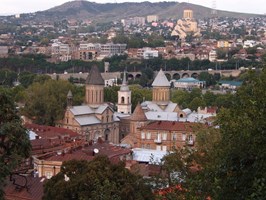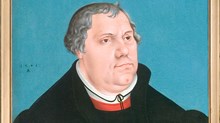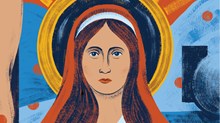Is an Armenian Church in Tbilisi the victim of "Georgianization"?

In late summer 2008, Russian and Georgian forces fought for control of a disputed region, South Ossetia. Among the complicating factors in that conflict were ethnic versus political boundaries, the possible return of Cold War tensions, and debate over which side fired the first shots. In this final week of the year, a different battle in Georgia has made the news, one pitting Georgians against Armenians for control of a disputed church.
As reported by Nina Akhmeteli of AFP, in the Georgian capital Tbilisi, two centuries-old stone churches share a courtyard. Jvaris Mama, a Georgian Orthodox church noted by the Lonely Planet guide for its "exquisitely pious and calm atmosphere," opens its doors to an active congregation. Its neighbor, Norashen Holy Mother of God Armenian Church, is locked, its walls and grounds marked by recent additions. The Georgian priest says the Norashen Church is undergoing renovations. Armenians complain that the church is the victim of "Georgianization," a systematic campaign to obscure Armenian heritage and rewrite the church's–and the country's–history.
Ethnicity and political control factor into this fight as in the August conflict with Russia. An ancient theological dispute remains relevant as well.
In the early fourth century, Armenia's King Tiridates III converted to Christianity, making Armenia possibly the world's oldest Christian society. (The dating of the king's conversion and the meaning of "Christian society" are subjects of vigorous discussion.) In the middle of the fifth century, though, the Armenian Apostolic Church found itself on the losing side of a Christological debate. The place was Chalcedon, today a district encompassed by Istanbul, and the topic was the relationship between Christ's human and divine natures.
The Council of Nicea in 325 had settled the matter of Christ's divinity by declaring him "God from God, Light from Light, true God from true God," "begotten, not made," and "from the substance of the Father." (If you sang all of the verses of "O Come, All Ye Faithful" this Christmas season, you recently reaffirmed these declarations.) But this left the puzzle of how Christ managed to be human and divine at the same time. Was he so divine that, as Ted pointed out in his Christmas carol rant, no crying he made in the manger? Was he so human that, as countless liberal theologians of the past century claimed, he would have been dismayed by his followers' assertions of his divinity? If the truth lay somewhere between those extremes, exactly where was it?
In a carefully woven tissue of Greek philosophical terms, the 451 Council of Chalcedon stated that Christ combined two natures in one person, "without confusion, change, division, or separation." His divinity persisted as one substance with the Father, while, during his life on earth, his humanity partook of our substance, in all particulars except sin. Seems clear enough, until you ask the investigative journalist's question, "What did he know, and when did he know it?" How did the fully divine Jesus grow "in wisdom and stature, and in favor with God and men" (Luke 2:52)? Perplexing. But that wasn't the initial problem.
The initial problem was the rejection by several Eastern churches of the council's formulation. These churches became known as non-Chalcedonian or Oriental Orthodox, and the Armenian Apostolic Church numbers among them. Relations between these churches and the churches of Eastern Orthodoxy have warmed of late, but, as the Tbilisi conflict demonstrates, members of the two bodies still sometimes treat each other coldly.
Of course, the fight over the Norashen Church is not primarily a rehashing of Chalcedon. Soviet-era abuses and the constant political pressures on Armenians–who have been subjects of some 30 empires over the centuries–provide more immediate context. Nonetheless, one fundamental challenge runs through the whole history: how to make of pieces one whole.
* * *
Public domain photo of central Tbilisi (2005) courtesy of Dmitri Gerasimov via Wikimedia Commons.

Support Our Work
Subscribe to CT for less than $4.25/month




























